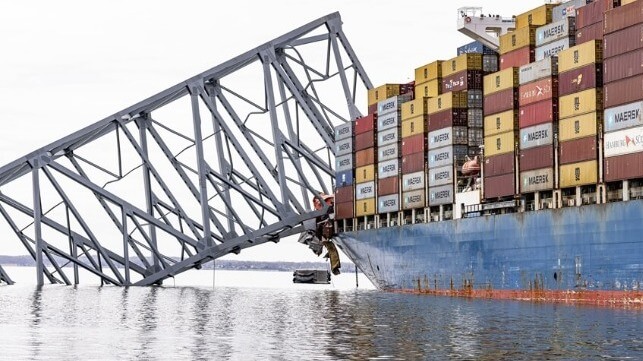Johns Hopkins Starts Large-Scale Study of Bridge Strike Risks

In the wake of the collapse of the Francis Scott Key Bridge, a team of experts at the Johns Hopkins Whiting School of Engineering are launching an in-depth study of all similar U.S. bridges to assess the risk of another disastrous ship strike.
Like much of America's aging infrastructure, the Key Bridge was designed and built more than 40 years ago. At the time, most cargo ships were far smaller, and bridge pier protection standards did not exist. In 1980, after a tanker struck and collapsed Florida's Sunshine Skyway Bridge, the Baltimore Sun quoted Maryland's top transport engineer saying that "a direct hit - it would knock [the Key Bridge] down."
The piers on the bridge's main span had one small dolphin to deter an allision on each side, and on March 26, the boxship Dali slipped easily past and hit the span's southwest pier. The entire steel truss bridge collapsed in seconds, killing six workers and trapping the Dali. Work to clear the federal channel is still under way.
"The Key Bridge collapse was a wake-up call," said team leader Michael Shields, a Johns Hopkins engineer specializing in risk assessment. "We need to know now, not five or 10 years from now, whether there is an outsize risk to bridges across the country so that critical investments - which will take years - can begin immediately if they are needed."
Shields' team believes that the chance of another catastrophic ship strike is likely higher than the engineering community expected. They will leverage a grant from the National Science Foundation and an "army" of engineering students to create new risk prediction models for bridge allisions involving big, modern vessels, looking at the probability of another strike and the probability of a strike causing a bridge collapse.

that matters most
Get the latest maritime news delivered to your inbox daily.
The team will focus on other big bridges over major ship channels, following a path traced by the Washington Post and the New York Times. Their results are expected within a year's time, and could support major revisions to safety standards for bridge construction and protection.
"The U.S. has seen 17 incidents of major bridge collapse between 1960 and 2011, averaging one every three years. Between the exponential growth of mega freight ships and the surge in global shipping traffic, many of our bridges simply weren’t built to withstand the pressures of today’s maritime landscape," said team member Rachel Sangree, a structural engineer and former bridge inspector. "Preliminary findings already challenge prevailing assumptions."
